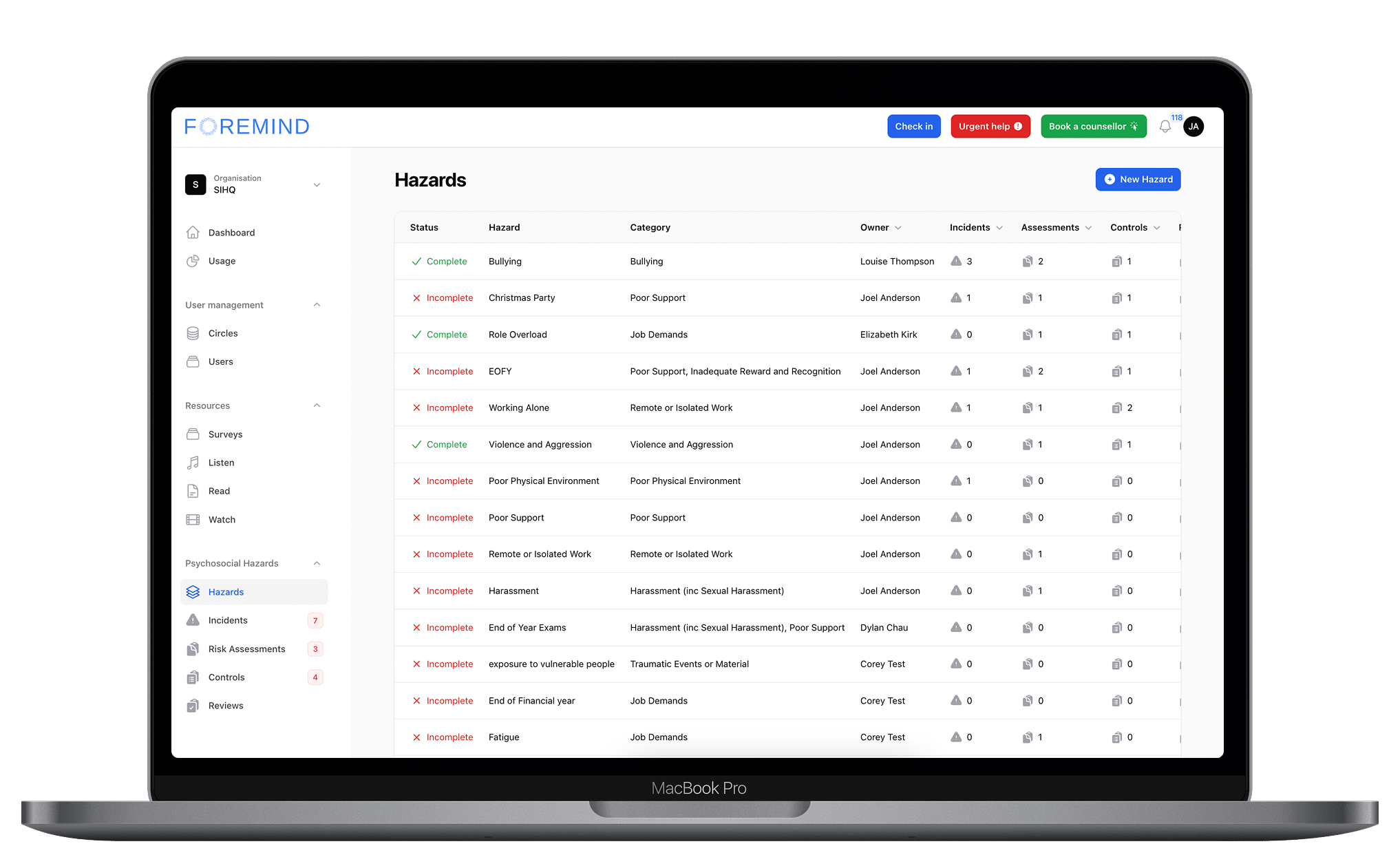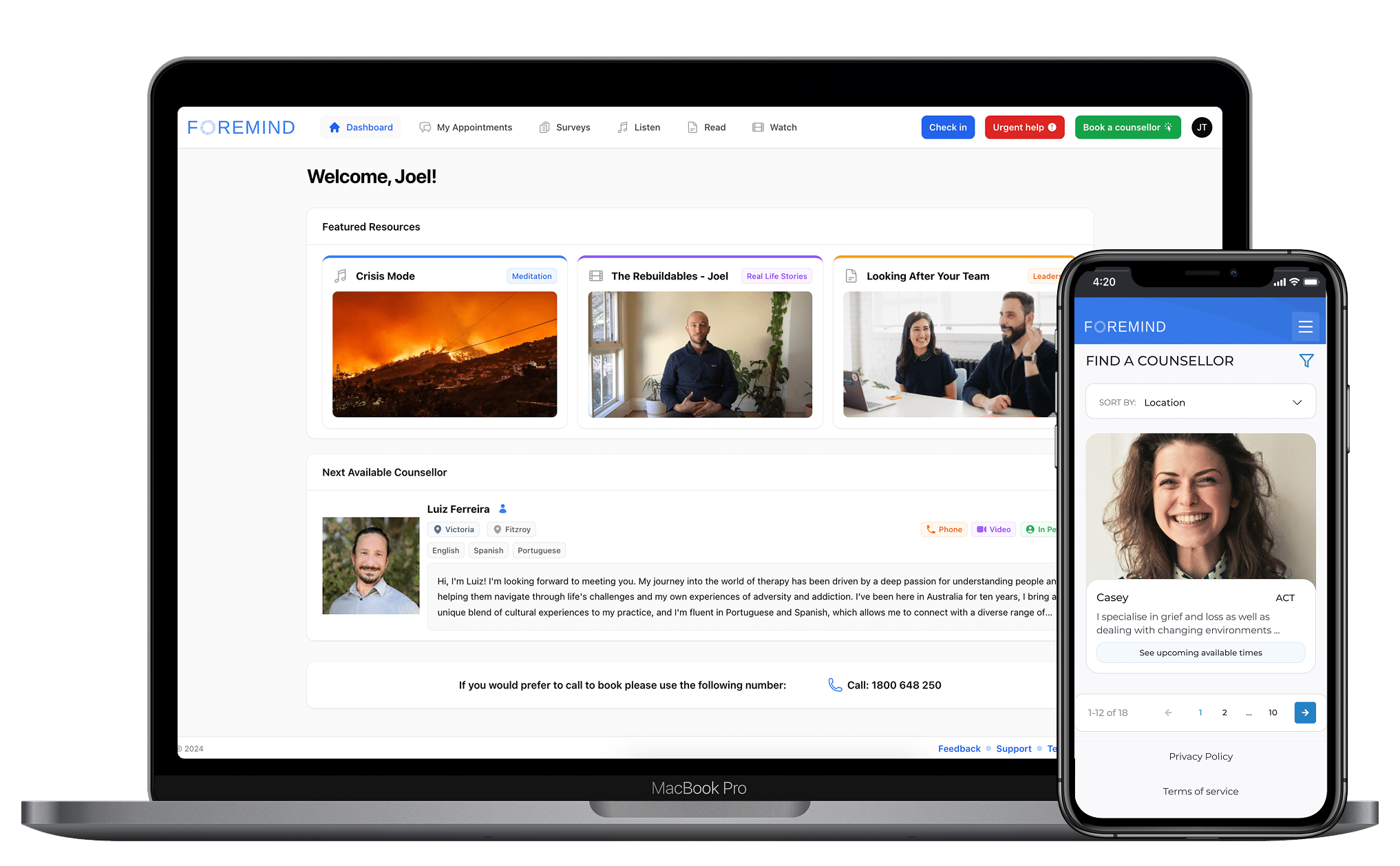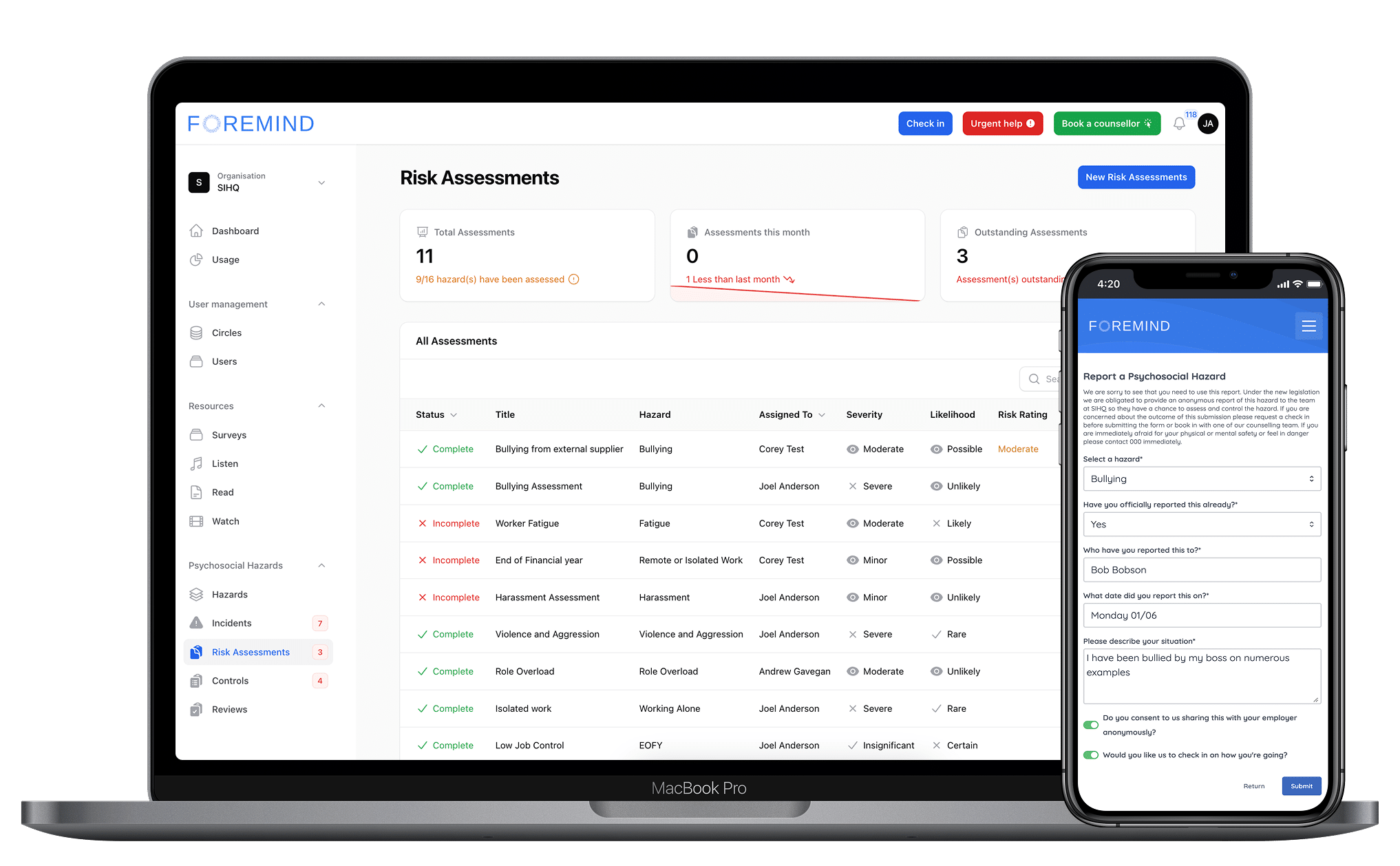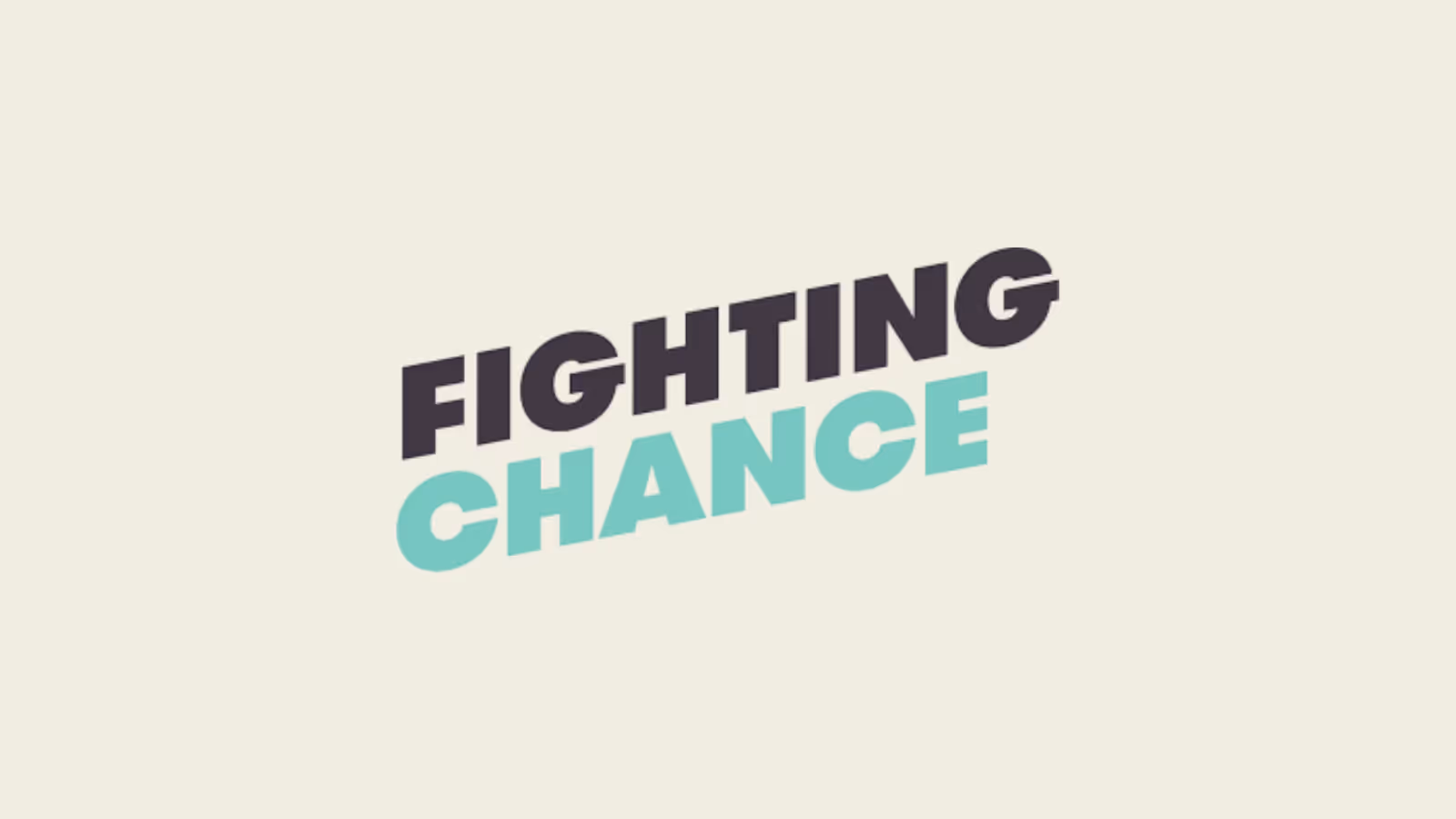Create A Risk Assessment In Minutes With Foremind.
Create risk assessments against a single hazard or interacting ones has never been this simple.

Trusted by Hundreds of Leading Australian Businesses
What Are Psychosocial Hazards?
Psychosocial hazards in the workplace stem from work design, the work environment, and workplace interactions and relationships.
These hazards can cause stress, leading to potential psychological and physical harm if not addressed. The implications are not only costly for businesses but also significantly impact individuals and their families.
Therefore, businesses must follow a four-step process according to the Code of Practice to manage these hazards:
- Identify
- Assess
- Control
- Review.


Risk identification and management
Use surveys and assessments to identify workplace mental health risks. Real time reporting dashboards track employee wellbeing & compliance.
Identifying Psychosocial Hazards Through Risk Assessments
In the identification phase, a multifaceted approach can be used to pinpoint concerns and proactively manage these hazards.
Understanding the sources and types of psychosocial hazards is the first step in identification of psychosocial hazards in the workplace for business to meet their compliance requirements.
The process of identifying the psychosocial hazards specific to your workplace involves working collaboratively, gathering data and using evidence based tools, and getting staff feedback through reporting. For more information on Identifying Psychosocial hazards see here.
Purpose of a Risk Assessment
The primary goal of conducting a psychosocial risk assessment is to systematically identify, evaluate, and prioritise hazards that could adversely impact employees’ psychological and physical health.It is recommended you use risk assessment tool to systematically address hazards both in isolation and the cumulative harm. To ensure your business is meeting its compliance requirements it is essential the assessment is clearly documented, as well as the process and outcomes required afterwards.Foremind can help you easily meet your compliance requirements with our hazard management platform that gives you all the tools to complete a systematic risk assessment.

Assessing the Risks
A thorough psychosocial risk assessment helps identify anything at work that could cause harm to employees, so you can take action early. This means:
- Figuring out what the hazards are.
- Looking at how often and how long workers are exposed to them.
- Considering how serious the harm could be if nothing changes.
By breaking it down this way, you can better understand the risks and take steps to prevent issues before they happen.
- Duration of Exposure: How long are employees exposed to specific hazards or stressful conditions?
Tip: Prolonged exposure to low level stressors, and high impact stressors can increase the likelihood and severity of adverse effects on mental health. Single incidents of chronic stress can also cause psychological harm.
- Frequency of Exposure: How often do employees encounter psychosocial hazards?
To be considered a psychological risk exposure must be enduring and for prolonged periods.
- Severity of Exposure: How severe are the hazards and their potential impacts on employees
Some hazards, such as workplace bullying or traumatic events, can have profound and immediate effects on mental well-being. However chronic ongoing exposure to lower level severity can also cause harm
Remember to consider psychosocial hazards collectively rather than in isolation. Workers and others may be exposed to more than one psychosocial hazard at any time and hazards can interact or combine, this means you may need to assess risks in a cluster or within a wider context.
Considering Combined Psychosocial Risks
The primary goal of conducting a psychosocial risk assessment is to systematically identify, evaluate, and prioritise hazards that could aPsychosocial risks will often partner and interact with each other, which increases the risk and the severity of the employees’ psychological well-being. For example, consider an employee experiencing high job demands and poor support compared to someone experiencing only one, they are at a greater risk of stress-related health issues. Now consider a third hazard of bullying accompanied with high job demands and poor support and we can begin to see how risks in combinations can evaluate an individuals risk profile.dversely impact employees’ psychological and physical health.It is recommended you use risk assessment tool to systematically address hazards both in isolation and the cumulative harm. To ensure your business is meeting its compliance requirements it is essential the assessment is clearly documented, as well as the process and outcomes required afterwards.Foremind can help you easily meet your compliance requirements with our hazard management platform that gives you all the tools to complete a systematic risk assessment.
Trauma-Informed Risk Assessments
A comprehensive risk assessment considers the interaction and cumulative effect of multiple psychosocial hazards rather than evaluating each hazard in isolation.This holistic approach provides a more accurate understanding of the overall risk profile within an organization and allows for prioritisation of interventions based on their collective impact as opposed to single incidents. Therefore, it’s crucial to assess how different hazards may exacerbate each other and collectively contribute to overall risk.


Psychosocial Risk Assessment Example
Shane works in a hospital as a nurse. Recently there have been many near misses and the hospital management has been increasing the reporting requirements and putting staff under investigation if mistakes are made.This has lead to lots of internal conflict where staff are blaming each other, managers are micro-managing staff and staff are feeling harassed as they can’t get everything done in time with the additional reporting requirements.As staff become more stressed they take more sick leave putting pressure on the remaining staff. Shane is feeling anxious every time he comes to work and checks the roster to see not enough staff on.What are the hazards identified in this scenario?Conflict/poor relationshipsJob demandsWhat is the frequency of the hazards? Most shifts or all, frequently enough to be considered a risk.The severity of the exposure? Shane is reporting he is feeling anxiousFurther questions,Is it affecting many workers or just one?Is this considered a one-off incident or a systemic issue?What existing controls are in place?What is the severity of impacts of the ongoing exposure
Access Easy Risk Assessment Tools With Our Platform
Foremind helps business to manage all the requirements of a psychosocial risk assessment in our Psychosocial Safety Platform. Using the platform to complete your risk assessment in alignment with the Code of Practice will ensure you have systematically documented your process and actions to meet your requirements.
No need to use archaic risk registers and spreadsheets, Foremind ensures all your documents are under one simple platform, saving you hours of administration and filing.
Manage all your identified hazardsEnable business to easily conmplete a psychosocial risk assessmentManage all key documents and reporting requirementsKeep track of all upcoming controls and reviewsAllow employees to report incidents (including anonymously)Support identification of hazards and risks across the business

The Psychosocial Hazard Domains
- Low Job Control
- Poor Support
- Lack of Role Clarity
- Poor Change Management
- Lack of Recognition
- Poor Organisational Justice
- Traumatic Events
- Remote or Isolated Work
- Conflict & Poor Relationships
- Poor Physical Environment
- Violence
- Harassment (including sexual harassment)
- Bullying
Our EAP Services
EAP Counselling
Support your team with workplace counselling for a range of mental and work-related stress.
Psychosocial Risk Assessments
Systematically identify, evaluate, and prioritise hazards that could adversely impact employees’ psychological and physical health.
Psychosocial Hazards Compliance
Foremind gives you the ability to support your teams mental health and manage your compliance in one place.Tailored to meet individual needs, whether employees are returning to work, planning retirement, or facing management challenges. We provide specialised sessions addressing specific issues like stress management and career transitions, ensuring targeted assistance for personal and professional development.
Hazard Reporting
Businesses have an obligation under the code of practice to ensure they have a process to identify hazards, with reporting being a key part of the obligations.
Critical Incident Response
Every workplace, regardless of size or industry, is susceptible to critical incidents – our platform helps you respond quickly and effectively.
Mental Health Training
Creating a positive safety climate in your business starts with training. Foremind supports businesses to achieve their wellbeing goals by offering tailored programs.

